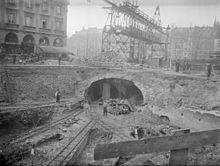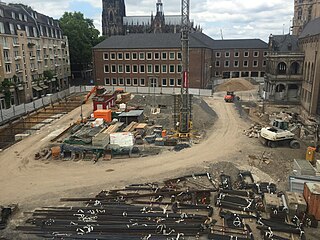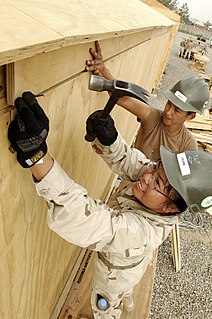
Underground construction refers to the construction of underground tunnels, shafts, chambers, and passageways, [1] it is also sometimes used to describe the portion of traditional construction that takes place below grade.

Underground construction refers to the construction of underground tunnels, shafts, chambers, and passageways, [1] it is also sometimes used to describe the portion of traditional construction that takes place below grade.
Neanderthals also engaged in underground construction but they were believed to be less sophisticated in that regard than humans. Neanderthal construction sites in France have been dated to 174,000 bc, far earlier than the earliest human sites. [2] Human underground construction likely began with cave dwelling pre-historic people who wanted to expand their home. [3] The purpose of many ancient underground structures is a mystery, for instance erdstalls which are found across Europe. [4] All ancient civilizations practiced some form of underground construction with some also branching into rock-cut architecture. In early urban centers underground spaces served as burial places, provided protection against invaders, and enabled early public utilities. [3]
The first known use of gunpowder in underground construction occurred in France in 1681. The invention of dynamite and steam and compressed air powered drills in the 18th century revolutionized the industry. The 19th century saw innovations in shield tunneling techniques which made underground construction in soil safer. As nations urbanized the extent of underground urban construction increased significantly with improved sewers, public water systems, subways, and underground commercial spaces all being required by expanding cities. In the late 20th and early 21st century advances in automation and geotechnical engineering have allowed the ambition and scale of underground construction projects to increase. [5] [6]
Archeology in major cities often requires the use of underground construction techniques as excavations must be made without disturbing existing buildings on the site. Underground museums have been created to preserve historical structures in-situ and without altering the often historically significant building built above. [7] [8] Archeological sites are also commonly discovered during underground construction. [9]
Underground construction has a number of unique risks and challenges but shares a lot with traditional construction and mining. Underground construction workers often work under reduced light condition, in dangerous spaces, and are at a high risk of exposure to contaminants, fire, and explosions. In the United States the Occupational Safety and Health Administration (OSHA) first adopted unique regulations for underground construction in 1971. OSHA regulates underground construction by companies and federal agencies but does not regulate underground construction activities associated with mining. [1] Underground construction is one of the most dangerous industries in the world but is becoming safer, especially as the most dangerous jobs are automated. [10]

Tunnels are the most common man-made subterranea. They have been constructed by various means since prehistory. [5]
Historically a wide variety of fortifications were either underground or partially below grade. Modern underground military facilities (primarily designed to resist aerial attack) emerged during the second world war and pre-war period. During the later years of WWII Nazi Germany moved much of its military industry underground. The Nazis used prisoners of war and slave labor to build their underground structures and large numbers perished during construction. [11]
The Cold War brought about two new underground structures, the nuclear powers built missile silos and all world powers built leadership protection bunkers in response. Examples of the latter include the Cheyenne Mountain Complex, Metro-2, and the Underground City (Beijing). [11]

In organic chemistry, isocyanate is the functional group with the formula R−N=C=O. Organic compounds that contain an isocyanate group are referred to as isocyanates. An organic compound with two isocyanate groups is known as a diisocyanate. Diisocyanates are manufactured for the production of polyurethanes, a class of polymers.

A firefighter is a first responder and rescuer extensively trained in firefighting, primarily to extinguish hazardous fires that threaten life, property, and the environment as well as to rescue people and in some cases or jurisdictions also animals from dangerous situations. Male firefighters are sometimes referred to as firemen.

A tunnel is an underground passageway, dug through surrounding soil, earth or rock, and enclosed except for the entrance and exit, commonly at each end. A pipeline is not a tunnel, though some recent tunnels have used immersed tube construction techniques rather than traditional tunnel boring methods.

A trench is a type of excavation or in the ground that is generally deeper than it is wide, and narrow compared with its length.

Scaffolding, also called scaffold or staging, is a temporary structure used to support a work crew and materials to aid in the construction, maintenance and repair of buildings, bridges and all other man-made structures. Scaffolds are widely used on site to get access to heights and areas that would be otherwise hard to get to. Unsafe scaffolding has the potential to result in death or serious injury. Scaffolding is also used in adapted forms for formwork and shoring, grandstand seating, concert stages, access/viewing towers, exhibition stands, ski ramps, half pipes and art projects.
The Occupational Safety and Health Administration is a large regulatory agency of the United States Department of Labor that originally had federal visitorial powers to inspect and examine workplaces. Congress established the agency under the Occupational Safety and Health Act OSH Act, which President Richard M. Nixon signed into law on December 29, 1970. OSHA's mission is to "assure safe and healthy working conditions for working men and women by setting and enforcing standards and by providing training, outreach, education, and assistance". The agency is also charged with enforcing a variety of whistleblower statutes and regulations. OSHA's workplace safety inspections have been shown to reduce injury rates and injury costs without adverse effects to employment, sales, credit ratings or firm survival.

Construction is a general term meaning the art and science to form objects, systems, or organizations, and comes from Latin constructio and Old French construction. To construct is the verb: the act of building, and the noun is construction: how something is built, the nature of its structure.

A mezzanine is an intermediate floor in a building which is partly open to the double-height ceilinged floor below, or which does not extend over the whole floorspace of the building, a loft with non-sloped walls. However, the term is often used loosely for the floor above the ground floor, especially where a very high-ceilinged original ground floor has been split horizontally into two floors.
Construction site safety is an aspect of construction-related activities concerned with protecting construction site workers and others from death, injury, disease or other health-related risks. Construction is an often hazardous, predominantly land-based activity where site workers may be exposed to various risks, some of which remain unrecognized. Site risks can include working at height, moving machinery and materials, power tools and electrical equipment, hazardous substances, plus the effects of excessive noise, dust and vibration. The leading causes of construction site fatalities are falls, electrocutions, crush injuries, and caught-between injuries.

A dugout or dug-out, also known as a pit-house or earth lodge, is a shelter for humans or domesticated animals and livestock based on a hole or depression dug into the ground. Dugouts can be fully recessed into the earth, with a flat roof covered by ground, or dug into a hillside. They can also be semi-recessed, with a constructed wood or sod roof standing out. These structures are one of the most ancient types of human housing known to archaeologists, and the same methods have evolved into modern "earth shelter" technology.

A respirator is a device designed to protect the wearer from inhaling hazardous atmospheres, including fumes, vapours, gases and particulate matter such as dusts and airborne pathogens such as viruses. There are two main categories: the air-purifying respirator, in which respirable air is obtained by filtering a contaminated atmosphere, and the air-supplied respirator, in which an alternate supply of breathable air is delivered. Within each category, different techniques are employed to reduce or eliminate noxious airborne contaminants.

A confined space is a space with limited entry and egress and not suitable for human inhabitants. An example is the interior of a storage tank, occasionally entered by maintenance workers but not intended for human occupancy. Hazards in a confined space often include harmful dust or gases, asphyxiation, submersion in liquids or free-flowing granular solids, electrocution, or entrapment.

The term immediately dangerous to life or health (IDLH) is defined by the US National Institute for Occupational Safety and Health (NIOSH) as exposure to airborne contaminants that is "likely to cause death or immediate or delayed permanent adverse health effects or prevent escape from such an environment." Examples include smoke or other poisonous gases at sufficiently high concentrations. It is calculated using the LD50 or LC50. The Occupational Safety and Health Administration (OSHA) regulation defines the term as "an atmosphere that poses an immediate threat to life, would cause irreversible adverse health effects, or would impair an individual's ability to escape from a dangerous atmosphere."

Underground living refers to living below the ground's surface, whether in natural or manmade caves or structures. Underground dwellings are an alternative to above-ground dwellings for some home seekers, including those who are looking to minimize impact on the environment. Factories and office buildings can benefit from underground facilities for many of the same reasons as underground dwellings such as noise abatement, energy use, and security.

Noise control or noise mitigation is a set of strategies to reduce noise pollution or to reduce the impact of that noise, whether outdoors or indoors.

A physical hazard is an agent, factor or circumstance that can cause harm with contact. They can be classified as type of occupational hazard or environmental hazard. Physical hazards include ergonomic hazards, radiation, heat and cold stress, vibration hazards, and noise hazards. Engineering controls are often used to mitigate physical hazards.

Occupational safety and health (OSH), also commonly referred to as occupational health and safety (OHS), occupational health, or occupational safety, is a multidisciplinary field concerned with the safety, health, and welfare of people at work. These terms also refer to the goals of this field, so their use in the sense of this article was originally an abbreviation of occupational safety and health program/department etc.

Barricade tape is brightly colored tape that is used to warn or catch the attention of passersby of an area or situation containing a possible hazard. It acts as a minor impediment to prevent accidental entrance to that area or situation and as a result enhances general safety. Barricade tape is also known as construction tape or barrier tape or in reference to the safety hazard involved as caution tape, warning tape, danger tape or hazard tape. When used by a police force, the tape is named police tape.
Subterranean warfare is warfare carried out under the ground surface.
Underwater construction is industrial construction in an underwater environment. There is often, but not necessarily, a significant component of commercial diving involved. It is a part of the marine construction industry.